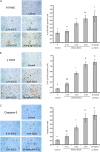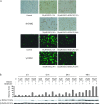Pro-oxidative activities and dose-response relationship of (-)-epigallocatechin-3-gallate in the inhibition of lung cancer cell growth: a comparative study in vivo and in vitro
- PMID: 20159951
- PMCID: PMC2864413
- DOI: 10.1093/carcin/bgq039
Pro-oxidative activities and dose-response relationship of (-)-epigallocatechin-3-gallate in the inhibition of lung cancer cell growth: a comparative study in vivo and in vitro
Abstract
(-)-Epigallocatechin-3-gallate (EGCG), the major polyphenol in green tea, has been shown to inhibit tumorigenesis and cancer cell growth in animal models. Nevertheless, the dose-response relationship of the inhibitory activity in vivo has not been systematically characterized. The present studies were conducted to address these issues, as well as the involvement of reactive oxygen species (ROS), in the inhibitory action of EGCG in vivo and in vitro. We characterized the inhibitory actions of EGCG against human lung cancer H1299 cells in culture and in xenograft tumors. The growth of tumors was dose dependently inhibited by EGCG at doses of 0.1, 0.3 and 0.5% in the diet. Tumor cell apoptosis and oxidative DNA damage, assessed by the formation of 8-hydroxy-2'-deoxyguanosine (8-OHdG) and phosphorylated histone 2A variant X (gamma-H2AX), were dose dependently increased by EGCG treatment. However, the levels of 8-OHdG and gamma-H2AX were not changed by the EGCG treatment in host organs. In culture, the growth of viable H1299 cells was dose dependently reduced by EGCG; the estimated concentration that causes 50% inhibition (IC(50)) (20 microM) was much higher than the IC(50) (0.15 microM) observed in vivo. The action of EGCG was mostly abolished by the presence of superoxide dismutase (SOD) and catalase, which decompose the ROS formed in the culture medium. Treatment with EGCG also caused the generation of intracellular ROS and mitochondrial ROS. Although EGCG is generally considered to be an antioxidant, the present study demonstrates the pro-oxidative activities of EGCG in vivo and in vitro in the described experimental system.
Figures






Similar articles
-
Synergistic inhibition of lung cancer cell lines by (-)-epigallocatechin-3-gallate in combination with clinically used nitrocatechol inhibitors of catechol-O-methyltransferase.Carcinogenesis. 2014 Feb;35(2):365-72. doi: 10.1093/carcin/bgt347. Epub 2013 Oct 22. Carcinogenesis. 2014. PMID: 24148818
-
Negative modulation of mitochondrial oxidative phosphorylation by epigallocatechin-3 gallate leads to growth arrest and apoptosis in human malignant pleural mesothelioma cells.Biochim Biophys Acta. 2013 Dec;1832(12):2085-96. doi: 10.1016/j.bbadis.2013.07.014. Epub 2013 Aug 2. Biochim Biophys Acta. 2013. PMID: 23911347
-
Epigallocatechin-3-gallate induces cell apoptosis of human chondrosarcoma cells through apoptosis signal-regulating kinase 1 pathway.J Cell Biochem. 2011 Jun;112(6):1601-11. doi: 10.1002/jcb.23072. J Cell Biochem. 2011. PMID: 21328612
-
Effects of the Green Tea Polyphenol Epigallocatechin-3-Gallate on Glioma: A Critical Evaluation of the Literature.Nutr Cancer. 2018 Apr;70(3):317-333. doi: 10.1080/01635581.2018.1446090. Epub 2018 Mar 23. Nutr Cancer. 2018. PMID: 29570984 Review.
-
Nanochemoprevention: sustained release of bioactive food components for cancer prevention.Nutr Cancer. 2010;62(7):883-90. doi: 10.1080/01635581.2010.509537. Nutr Cancer. 2010. PMID: 20924964 Free PMC article. Review.
Cited by
-
Dietary agents for prevention and treatment of lung cancer.Cancer Lett. 2015 Apr 10;359(2):155-64. doi: 10.1016/j.canlet.2015.01.038. Epub 2015 Jan 30. Cancer Lett. 2015. PMID: 25644088 Free PMC article. Review.
-
Randomized clinical trial of brewed green and black tea in men with prostate cancer prior to prostatectomy.Prostate. 2015 Apr 1;75(5):550-9. doi: 10.1002/pros.22943. Epub 2014 Dec 24. Prostate. 2015. PMID: 25545744 Free PMC article. Clinical Trial.
-
Green tea polyphenol extract in vivo attenuates inflammatory features of neutrophils from obese rats.Eur J Nutr. 2016 Apr;55(3):1261-74. doi: 10.1007/s00394-015-0940-z. Epub 2015 Jun 2. Eur J Nutr. 2016. PMID: 26031433
-
Epigallocatechin-3-gallate Synergistically Enhanced Arecoline-Induced Cytotoxicity by Redirecting Cycle Arrest to Apoptosis.Curr Issues Mol Biol. 2024 Feb 14;46(2):1516-1529. doi: 10.3390/cimb46020098. Curr Issues Mol Biol. 2024. PMID: 38392216 Free PMC article.
-
Flavonoids and Colorectal Cancer Prevention.Antioxidants (Basel). 2018 Dec 10;7(12):187. doi: 10.3390/antiox7120187. Antioxidants (Basel). 2018. PMID: 30544686 Free PMC article. Review.
References
-
- Yang CS, et al. Tea and cancer. J. Natl Cancer Inst. 1993;85:1038–1049. - PubMed
-
- Lambert JD, et al. Inhibition of carcinogenesis by polyphenols: evidence from laboratory investigations. Am. J. Clin. Nutr. 2005;81:284S–291S. - PubMed
-
- Yang CS, et al. Inhibition of carcinogenesis by tea. Annu. Rev. Pharmacol. Toxicol. 2002;42:25–54. - PubMed
-
- Naasani I, et al. Blocking telomerase by dietary polyphenols is a major mechanism for limiting the growth of human cancer cells in vitro and in vivo. Cancer Res. 2003;63:824–830. - PubMed
Publication types
MeSH terms
Substances
Grants and funding
LinkOut - more resources
Full Text Sources
Medical

